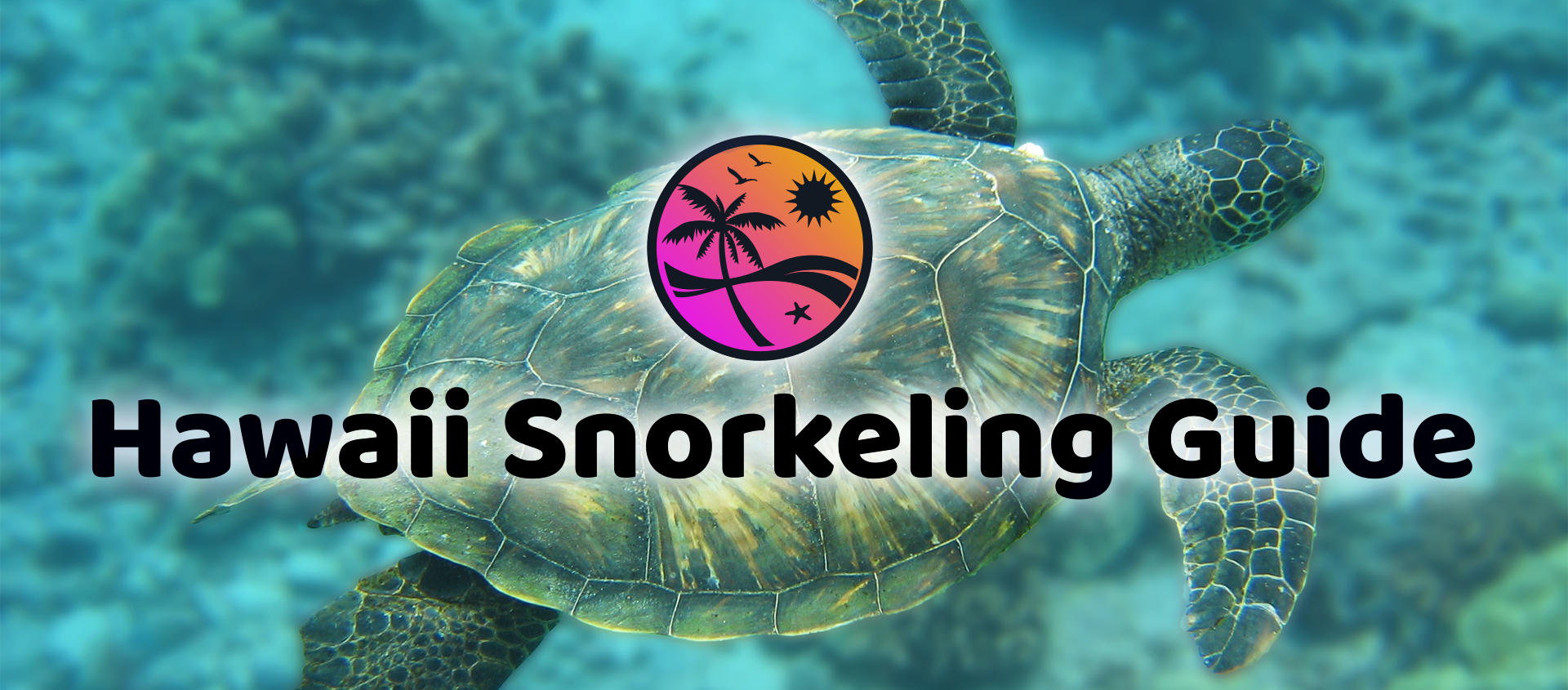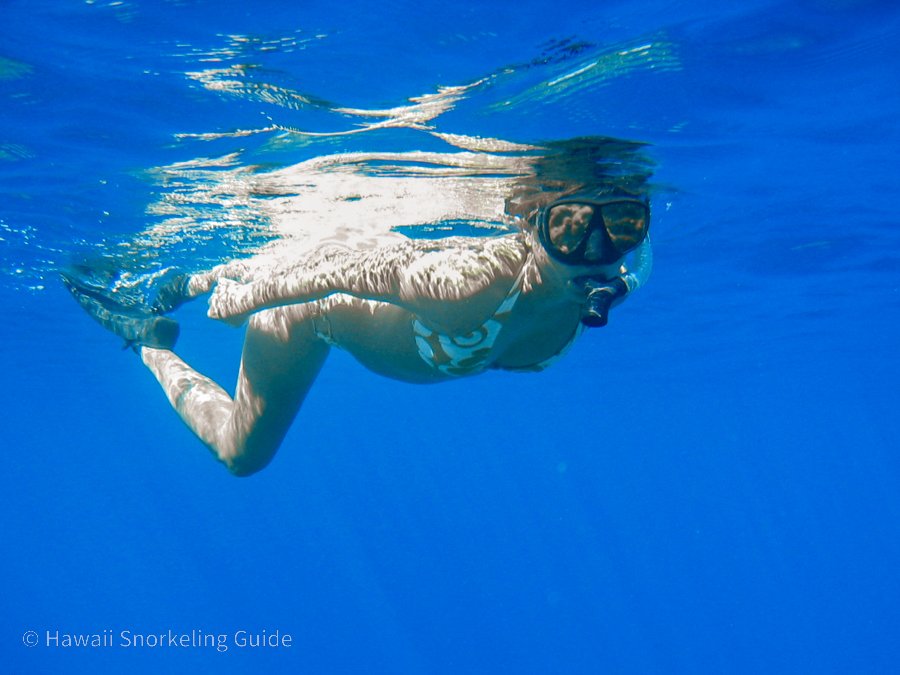Your window to Hawaii’s underwater paradise
See that guy in the water who keeps stopping to take off his mask?
Do you know why he’s spending his time fiddling with his mask instead of enjoying the beautiful underwater view?
Because no one showed him how to choose his snorkeling mask wisely.
But that’s not something you’re going to have to worry about. By the time you’re finished reading this page you’ll know all the things to look for in a snorkeling mask, so you’ll be able to keep your head in the water.
The Most Important Thing to Look for in a Snorkeling Mask:
When choosing a snorkeling mask, your first and foremost criteria should always be a proper fit. The rubber-like portion of the mask that makes contact with your face is called the skirt. It’s purpose is to make a water tight seal against your skin. A skirt that doesn’t properly seal against your face causes a host of problems like leaking, fogging, and fatigue.
A slow leak between the skirt of the mask and your face means you’ll have to constantly tread water to empty it out. Treading water vertically takes much more energy than floating horizontally, tiring you quickly.
Lifting your mask away from your face to empty the water out will also make your mask fog. When you pull your mask away from your face, new moist air enters the mask and condenses against the cold inside lens surface. The more new air that’s introduced, the more moisture there will be to condense on your lens.
Never choose a mask solely because of the way it looks on the shelf or because someone told you it’s the “latest in mask technology”. Bottom line… be sure to find a proper fitting mask.
How to Find a Mask That Fits You:
The goal is to find a mask that fits your face so well, you forget you have it on while snorkeling. Everyone has a uniquely shaped face, therefore there is no single model that is best for everyone. Use this test to make sure you choose the right mask for you:
When you try on a mask, start by holding your breath, don’t inhale or exhale. Gently place the mask up against your face and press very slightly. Now let go of the mask with your hands. A well-fitting mask will stick to your face without you having to hold it in place. Remember not to inhale through your nose when you let go of the mask. You can make just about any mask stick to your face if you inhale through your nose hard enough. The better the mask seals to your face the less likely you’ll have any leaks when moving your head in the water. This one quick test will quickly narrow down the best mask for you by weeding out the masks that don’t fit you properly. No matter how much you liked the look of that mask when you took it off the shelf, if it doesn’t pass this test, find another mask.
A well-fitting mask will feel very comfortable since you won’t have to over tighten the mask strap to keep it from leaking. When putting on the mask strap, only tighten it enough to keep the mask from shifting on your face when you turn your head. The majority of the seal should come from the skirt of the mask, not the strap.
Also, if your hair is caught under the skirt of the mask, it will not make a good seal with your face and your mask will leak. Once you’re snorkeling it will be more difficult to remove your hair from your mask since you will be treading water. Try this: Before putting on your mask, wet your hair and slick it back out of your face. Now put your mask on and run your finger around the edge of the skirt to make sure no hair is caught under it.
Other Considerations When Choosing a Snorkeling Mask:
If while shopping, you happen to find more than one mask that you think fits equally well, then by all means choose the one that has the features you like. Just remember, all the considerations below come second to finding a mask that fits your face properly.
A wide skirt – When trying on different masks, take a look at the edge of the skirt; the portion that’s actually going to make contact with your skin. You’ll notice they come in varying widths. As a rule of thumb, the more of the edge that’s in contact with your skin, the more likely it will make a good seal.
Materials – If you’re going to purchase your own mask, be sure the skirt is made from silicone. Rubber skirts will become brittle and crack over time. Silicone masks will last dive after dive for many years.
Peripheral Visibility – With your mask on and while keeping your head still, roll your eyes in all directions and check your peripheral vision. You’ll notice some masks tend to make you feel tunnel-visioned while others make you feel like you’re sitting in front of a picture window. All else being equal, I’m sure you’re going to prefer the wider view.
No fog lens – Many manufacturers make special “no fog” lenses. Although no mask lens is absolutely “no fog”, they are extremely “low fog”. Minimum preparation will be needed to keep them crystal clear during your dive.
Vision Enhancing Coatings – Some lenses are made to increase underwater clarity during less-than-perfect light conditions. No, I don’t mean see-in-the-dark James Bond stuff. I mean a special tinting that makes images crisper and clearer by cutting down on glare and filtering certain wavelengths of incoming light. They actually do make a difference in your vision. I wouldn’t go out of my way to find these lenses but I thought I’d mention it so when you see them in the dive shop you’ll know what they are.
Low volume – Each time you dive under the surface, the weight of the water above you compresses the air inside your mask. The deeper you are, the more water there is above you, therefore the more pressure. To compensate for this pressure increase, you have to exhale slightly through your nose using the air from your lungs to fill your mask and equalize the pressure. Low volume masks, are designed with the lens closer to your face to reduce the inside air volume. How exactly does this help? Well, the less air volume there is within the mask, the less volume you will have to refill by exhaling through your nose. This benefits you by keeping more air inside your lungs where it’s needed. Also, as I said earlier, the less you have to exhale into your mask, the less likely it will fog. Clever don’t you think?
The Top 3 Ways to Keep Your Mask From Fogging:
1. Be sure your mask is properly fitted for your face – You knew I was going to say that didn’t you? What do you mean you skipped the sections above? If you have no idea what I’m talking about, see the sections above “What to look for in a snorkeling mask” and “How to find a mask that fits you”. If you already have, good for you! I knew I could count on you.
2. Avoid taking your mask on and off while snorkeling – The general rule is, once you put your mask on, leave it on. Every time you pull your mask away from your face, more new moist air enters your mask and condenses against the cold inside lens surface. The more new air that’s introduced, the more moisture there will be to condense on your lens. For the same reasons, avoid exhaling excessively through your nose. Some nasal exhalation is necessary while diving to re-pressurize your mask (see the section above “Low volume”), but try to keep it to a minimum.
3. Use mask defog – Defog is any substance that you can apply to the inside of your mask lens to prevent condensation. Defog solutions are great and really do work. You can find them in any dive shop. Just remember, no amount of defog will help if you don’t remember the two steps above.
You’ll be surprised how these three simple little things can significantly enhance your snorkeling experience.
Insider Tip: The defog solutions that are in the dive shops can be a little pricy so I actually use a type of car windshield cleaner called “20/10”. It comes in a little green and white flip top squirt bottle and can be found at just about anywhere you can find automotive supplies. I just pick mine up at the closest gas station or Wal-Mart. The bottle costs a little less than a dollar and it usually takes me almost a year to use it all. Talk about a deal! Since it comes in a small liquid-tight plastic bottle, I always just keep it with my mask and fins. Just squirt a little on your mask lens, rub it around with your finger, use a handful of water to rinse the excess out of your mask, and you’re good to go.
Other Helpful Snorkeling Gear Pages:
What you should know about snorkeling fins
What you should know about snorkels
What you should know about sunscreen

